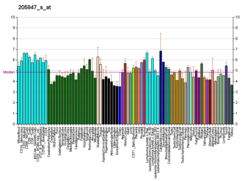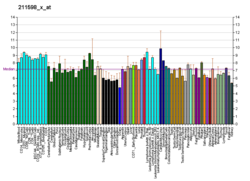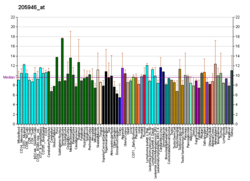Top Qs
Timeline
Chat
Perspective
VIPR2
Protein-coding gene in the species Homo sapiens From Wikipedia, the free encyclopedia
Remove ads
Vasoactive intestinal peptide receptor 2 also known as VPAC2, is a G-protein coupled receptor that in humans is encoded by the VIPR2 gene.[5]
Remove ads
Tissue distribution
VIPR2 is expressed in the uterus, prostate, smooth muscle of the gastrointestinal tract, seminal vesicles and skin, blood vessels and thymus.[6][7] VIPR2 is also expressed in the cerebellum.[8]
Function
Vasoactive intestinal peptide (VIP) and pituitary adenylate cyclase activating polypeptide (PACAP) are homologous peptides that function as neurotransmitters and neuroendocrine hormones. While the receptors for VIP (VIRP 1 and 2) and PACAP (ADCYAP1R1) share homology, they differ in their substrate specificities and expression patterns.[5] VIPR2 transduction results in upregulation of adenylate cyclase activity.[9] Furthermore, VIPR2 mediates the anti-inflammatory effects of VIP.[10]
Research using VPAC2 knockout mice implicate it in the function of the circadian clock, growth, basal energy expenditure and male reproduction.[11][12][13][14]
VIPR2 and/or PAC1 receptor activation is involved in cutaneous active vasodilation in humans.[15]
Splice variants may modify the immunoregulatory contributions of the VIP-VIPR2 axis.[16]
VIPR2 may contribute to autoregulation and/or coupling within the suprachiasmatic nucleus (SCN) core and to control of the SCN shell.[17]
Remove ads
Clinical significance
VIPR2 may play a role in schizophrenia.[18]
The abnormal expression of VIPR2 messenger RNA in gallbladder tissue may play a role in the formation of gall stones and polyps.[19]
See also
References
Further reading
External links
Wikiwand - on
Seamless Wikipedia browsing. On steroids.
Remove ads







